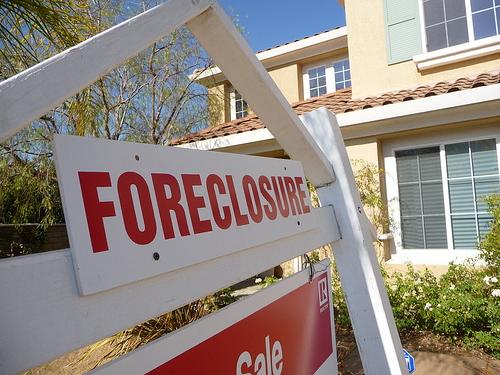‘Cramdown’ Plan Hits Wall in Senate
The cramdown provision meant to help desperate homeowners falters in the Senate, revealing the financial industry’s power on Capitol Hill.
Jul 31, 202029.8K Shares932.7K Views
Flickr: respres
A central element of the Democrats’ strategy to stabilize the economy — empowering homeowners to prevent foreclosures through bankruptcy — has hit a wall in the Senate, where fierce opposition from the finance industry is threatening to kill the proposal this week.
Despite major concessions to the banks at the expense of borrowers, Senate leaders have been unable, after weeks of negotiations, to persuade most industry players to endorse the proposal. Unless further genuflections are made to the banks, supporters of the bill appear unlikely to garner support from enough senators to defeat a mostly Republican filibuster — a vote that could occur as early as Thursday.
Illustration by: Matt Mahurin
The saga is just the first in what will likely be a series of hurdles as Democrats attempt to reform the finance industry this year with new protections for borrowers and consumers. Despite the epic fall of Wall Street — not to mention the trillions of dollars put up by Washington to rescue the ailing finance industry — the banks remain a lobbying juggernaut on Capitol Hill. And they’re using their influence to water down a host of consumer-friendly proposals this year — including credit card, mortgage lending and payday loan reforms.
The bankruptcy bill, sponsored by Sen. Richard Durbin (D-Ill.), permits bankruptcy judges to reduce, or “cramdown,” homeowners’ mortgage payments to help borrowers stay in their homes — an option currently available to save vacation homes, yachts and almost any other valuable asset, but not primary homes. The House passed a similar bill in March, but it’s been stalled in the upper chamber while Durbin and other Senate leaders tried for weeks to negotiate the support of the giants of the finance industry, including Bank of America, Wells Fargo, JP Morgan Chase and the Credit Union National Association.
To no avail. Only Citigroup, which endorsed the Senate bill earlier in the year, has signed on in support. And it wasn’t for a lack of concessions from Democrats. Indeed, behind Durbin, Senate leaders diluted the bill so that eligibility applies only to: (1) loans taken out before Jan. 1, 2009; (2) loans that are at least 60 days delinquent; (3) loans with outstanding balances of less than $729,750; and (4) loans for which homeowners were not offered a modification from their servicer — one compatible with either the Obama administration’s new anti-foreclosure plan or the Hope for Homeowners program. Also, the Durbin compromise sunsets the bankruptcy option in 2012.
“It’s a compromise six ways to Sunday to answer everyone’s concerns, and yet you’ve still got what looks like all the Republicans, and a handful of Democrats, who don’t want the bill,” said David Abromowitz, a housing expert at the progressive Center for American Progress. “[The banks] still have enormous political power on Capitol Hill.”
And it’s not only Republicans who are lined up with the banks. Indeed, the Huffington Post reported this week that Democratic Sens. Mary Landrieu (La.), Ben Nelson (Neb.) and Jon Tester (Mont.) plan to vote against the proposal, while a long list of other moderate Democrats remain on the fence.
Defeat of the bill would come at a tough time for homeowners. Foreclosure filings topped 800,000 in the first three months of this year, up 24 percent from 2008, according to RealtyTrac, an online foreclosure database. And the numbers are rising as unemployment jumps as well. Of the first quarter foreclosures, more than 341,000 came in March alone — up 17 percent from the month before.
A Credit Suisse report conducted in December found that the cramdown bill alone would prevent 20 percent of the nation’s foreclosures. A more recent analysis from Moody’s Economy.com found that Durbin’s proposal could prevent 1.7 million foreclosures nationwide.
Yet the finance industry and Republicans have blasted the bankruptcy change as adding another layer of uncertainty to the borrower-lender relationship. If judges are permitted to alter the terms of mortgages to reduce the lenders’ profits, the critics argue, then those lenders will have little choice but to hike rates on other more reliable borrowers to compensate for the additional risk. Industry opponents also argue that the change would encourage homeowners to seek bankruptcy as a early option rather than a last resort — something consumer advocates and Democrats adamantly refute.
“They’re acting like it’s just a walk in the park to go into bankruptcy,” said Linda Sherry, director of national priorities at Consumer Action. “It’s not. It’s a life-altering process. It’s not something that you go out and do just because you want to screw a bank.”
Considering all the bailout money doled out to Wall Street in recent months, Sherry added, it’s high time Congress focused some of that largess on Main Street as well. “Corporate America has gotten enough welfare,” she said. “It’s time to help the people who are in distress.”
Speaking from the Senate floor Tuesday night, Durbin laid out his own theory why the industry opposes cramdown. “They don’t like this change,” he said, “because it means at the end of the day, if they will not sit down with someone facing foreclosure to try to work out and renegotiate the terms of the mortgage — at the end of the day that person may go to bankruptcy court and end up having a judge do it … [T]hat is why many of the banks resist it. They don’t want to sit down and renegotiate the terms of the mortgage.”
A failure of cramdown in the Senate would mark a defeat for the Obama administration, which is supporting the proposal as a complementary element of its foreclosure prevention strategy. Unveiled in February, that plan offers mortgage lenders and servicers a number of financial incentives to modify troubled loans voluntarily. Housing experts say the threat of bankruptcy is a necessary accompaniment to the administration’s voluntary enticements.
“The Obama plan has some carrots,” Abromowitz said, “but they’re pretty small carrots if there’s not a stick behind them.”
The Senate bottleneck has placed some housing advocates in the uncomfortable position of supporting the diluted Durbin Senate compromise for the singular reason that it’s better than having no bankruptcy language at all. Ellen Harnick, senior policy counsel for the Center for Responsible Lending, an advocacy group, said the compromise is “substantially limited,” yet without some threat of bankruptcy “there’s nothing to compel the lender to participate in the Obama modification plan.”
David Berenbaum, executive vice president of the National Community Reinvestment Coalition, relayed a similar message, arguing that the compromise “is certainly watered down, but will help a lot of consumers.” Berenbaum said a particular advantage of the Durbin proposal is a provision that would force lenders, as a condition of precluding bankruptcy, to reduce monthly mortgage payments as low as 25 percent of the homeowner’s income in the case of low- and moderate-income borrowers — a good deal lower than the 31 percent demanded under the Obama plan.
“Each day that we wait, there are thousands of consumers who are facing foreclosure,” Berenbaum said.
The Senate is scheduled to begin debating housing legislation Thursday, with the cramdown provision likely arriving as an amendment to the larger bill. Durbin warned the finance industry Tuesday that a failure to pass cramdown this week wouldn’t dissuade him from trying again soon.
“I might say to the bankers, if you beat me this week — I hope you do not, but if you do — hang on tight. We are coming back at you next week.”

Paula M. Graham
Reviewer
Latest Articles
Popular Articles

